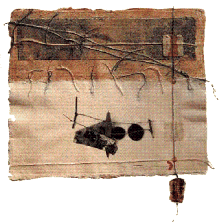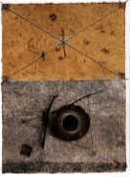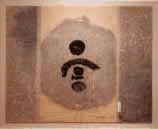

|
sticks & stones |

Symbols in Ritual 1992/4A |
Bits of string, smooth stones, twigs and scraps of shiny paper-it's the stuff of children's pockets.
For Thai artist Thavorn Ko-Udomvit, it's also the stuff of memory: an annual pilgrimage to worship ancestors, taking a rare trip by car through the teeming streets of Bangkok; the careful laying out of food to the dead, sticks and stones rattled to frighten unwanted spirits; scraps of gold and silver paper burnt in offering.
And because of their symbolic power, stones, twigs, paper and string are an integral part of his art, which explores the essence of culture and our connection with family, humanity and worlds beyond knowing.

Symbols in Ritual 1992/5 |
"I get inspiration from the Chinese ritual," says Ko-Udomvit, whose father was Chinese. He explains a work from his Ritual series by pointing to the simple circle representing the food offering, the noisemakers, dark borders to represent the world of the dead and the strings that bind our world to theirs.
A second series, Fetish, expands his look at ritual to an examination of the objects themselves.
"Before my father died, I went to the hospital every day," says Ko-Udomvit. "In that hospital, they had a lot of books on Buddhism. I had nothing to do, so I read them."
The art those books inspired looked first at tiny buffalo, bird and pig charms, the stock in trade of Thai monasteries, which, says Ko-Udomvit, symbolize irrational beliefs that lead to a life of illusion. In one work, the tiny amulets hang in lifeless lines encased in strips of plastic.

Fetish 1996/4 |
He compared these amulets to natural objects. "These objects, such as small stones, a dry twig fallen to the ground, have evolved from nature, and can give an understanding of the cycle of nature, and the accurate understanding of nature is the object of Buddhism and an important factor in leading a happy and tranquil life," he says.
His work draws on traditions centuries old yet remains decidedly contemporary. Modern touches include photo silkscreen and concrete objects embedded between layers and on top of the work.
However, his insistence on using only handmade rice paper in his work reflects a timeless artistic tradition. "I see that the paper produced in the factory is lifeless and doesn't reflect any spirit," he says. And spirit, he believes, is the heart of art.
"Sometimes if your technique is good, but it does not have any meaning or philosophy, it is just decoration."

Fetish 1995/K2 |
Thavorn Ko-Udomvit is artist-in-residence at the U of A until October 7 as part of a unique international symposium organized by the Department of Art and Design. Professor Liz Ingram says the Sightlines Symposium, Oct. 1 through 5, has already attracted more than 250 registrants from around the world. Printmaking symposia are held often, she says but, "This is probably the first one I've ever heard of that focuses not on technical workshops, but the kind of place we have and the role we play in history, politics and culture." The 32 guest speakers and panelists cross disciplines from art to political science, anthropology and feminist scholarship. A second artist-in-residence, Ryoji Ikeda of Japan will be on campus until August '98.
![[Folio]](http://www.ualberta.ca/~publicas/folio/gif/small/folio.gif)
Folio front page |
![[Office of Public Affairs]](http://www.ualberta.ca/~publicas/gif/small/opahome.gif)
Office of Public Affairs |
![[University of Alberta]](http://www.ualberta.ca/~publicas/gif/small/uahome.gif)
University of Alberta |